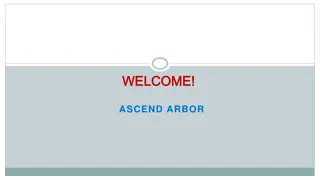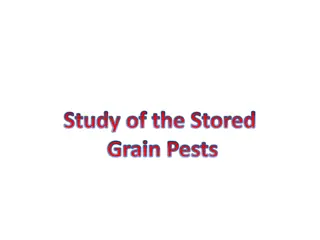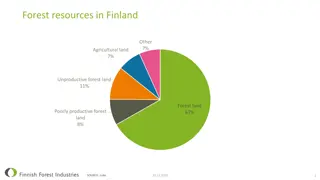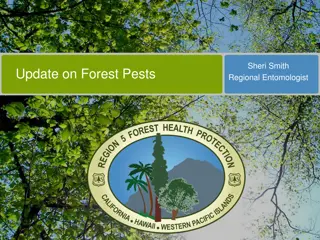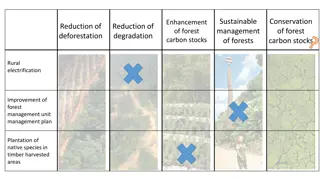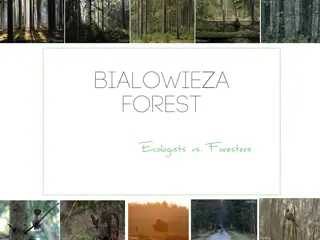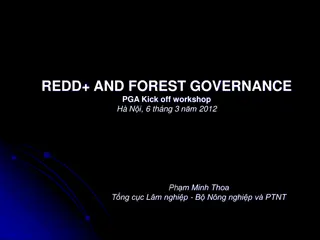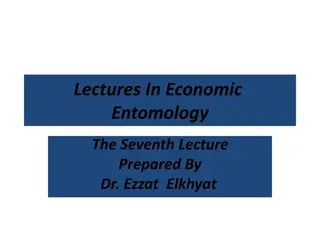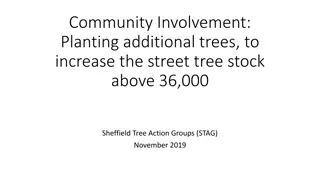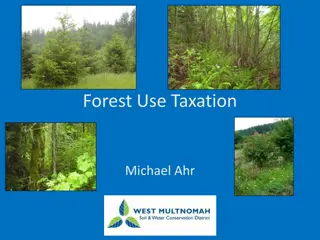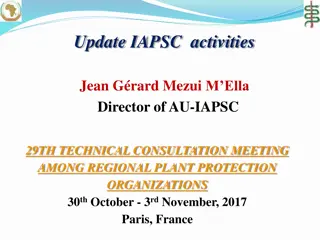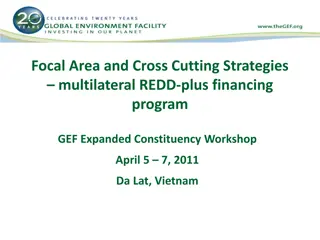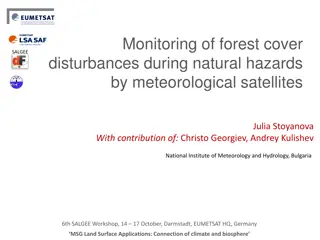Forest and Tree Pests and Diseases Management in Africa
The management of forest pests and diseases in Africa is crucial to safeguard the continent's forests, international trade, and forest products. This presentation provides insights into the occurrence, distribution, economic impacts, and regional cooperation for managing forest pests. Major pests and diseases affecting trees and forests across different African regions are discussed, highlighting the need for effective surveillance and control mechanisms.
Download Presentation

Please find below an Image/Link to download the presentation.
The content on the website is provided AS IS for your information and personal use only. It may not be sold, licensed, or shared on other websites without obtaining consent from the author.If you encounter any issues during the download, it is possible that the publisher has removed the file from their server.
You are allowed to download the files provided on this website for personal or commercial use, subject to the condition that they are used lawfully. All files are the property of their respective owners.
The content on the website is provided AS IS for your information and personal use only. It may not be sold, licensed, or shared on other websites without obtaining consent from the author.
E N D
Presentation Transcript
FOREST AND TREE PESTS AND DISEASES MANAGMENT IN AFRICA By The Inter-African Phytosanitary Council of African Union (AU-IAPSC)
OUTLINE INTRODUCTION OCCURRENCE, DISTRIBUTION AND MANAGEMENT OF FOREST PESTS IN AFRICA ECONOMIC IMPACTS OF FOREST PESTS IN AFRICA REGIONAL COOPERATION IN MANAGEMENT OF FOREST PEST INSTITUIONS AND INSTITUTIONAL CAPACITIES FOR FOREST PESTS CONTROL AND MANAGEMENT FOREST PESTS SURVEILLANCE MECHANISMS CONCLUSION
INTRODUCTION In Africa, the propagation of indigenous and exotic forestry pest constitutes an increase threat to the continent forest, international trade, forest products and others. Any pests and diseases that could impede growth increment and /or lower quality and volumes of wood are of economic importance and need to be addressed. The focus of this presentation is based on the synthesis report on recent forest health studies commissioned by the African Forest Forum (AFF) in Eastern, Southern, and West and Central Africa (Bosu,2016; Gichora, 2016; Kojwang,2015) as well as literature reviews on the Subject of management of forest pests and diseases in the North of the continent.
OCCURRENCE, DISTRIBUTION AND MANAGEMENT OF FOREST PESTS IN AFRICA The situation regarding occurrence, distribution and management of forest insect pests on the African continent was described in detail by FAO(2009). Defoliators are common problem in the belt of natural forest running across northern and central Africa. Main pests in west Africa are: the mahogany shoot borer, Hypsipyla robusta, the iroko gall louse, Phytolyma lata, ambrosia beetles, Sirex wood wasp, Thaumastocoris peregrinus of Eucalyptus; A comprehensive list of all types of pests that occur in Southern Africa are listed by Roux et al .(2012) and (Kojwang, 2015). tree locusts, termites and beetles are insect pests of forests in east Africa Thaumetopoea pityocampa, the pine processionary moth forests pests in north Africa. are the main
OCCURRENCE, DISTRIBUTION AND MANAGEMENT OF FOREST PESTS IN AFRICA CON`T Major diseases of trees and forests in west and Central Africa (Bosu,2016 ) A comprehensive study of diseases of eucalypts and pines has been reported by Alemu et al.(2003a). Non Fungal Infectious Forest Diseases include: Forest Diseases caused by viruses; - Forest disease caused by Prokaryotes: Phytoplasma and Bacterial Diseases - Forest Diseases caused by Higher Parasitic plants: Misletoes - Pine Wilt Disease and other Nematode Diseases. - Forest Diseases Caused by Fungi and Fungal-like Organisms ( Root and Butt Rots, Stem Rots, Vascular Diseases, Canker Diseases, Branch and Tip Blights Foliar Diseases, Oomycete Diseases, Rust Diseases and Nursery Diseases.
MANAGEMENT OF FOREST PESTS IN AFRICA Countries to establish a network to address the following activities: Training Information exchange, through a newsletter Collaborative research, detection and monitoring, screening of insecticides, ecological and socio-economic impact studies, integrated pest management Quarantine services Exchange of expertise Public awareness and education Sufficient attention to forest insect management by IAPSC
ECONOMIC IMPACTS OF FOREST PESTS IN AFRICA To determine the extent of economic loss attributed to poor forest, it is necessary to have data about disease and pest incidences and their effects on forest and forest products. In all of sub-Saharan Africa, pest problems of ecological and economic significance are few and of limited concern in naturally occurring forest stands. Pest impact becomes significant mainly in plantations (Bosu, 2016). In the humid forest zones of west and central Africa, Plantations of high value timber species such as iroko (milicia excels and M.regia) are attaked by iroko gall bug Phytolyma spp; and mahogany ( Khaya and Entandrophrama spp) are susceptible to the shoot borer hypsipyla robusta. Mitigating the impact of pests and pathogens requires an integrated approach which is based on decisions reached and action taken before an outbreak is detected Monitoring of forest pests and diseases and their resultant damage is a critical input to the IPM decision process. Regulatory, cultural or genetic tactics are examples of prevention strategies.
REGIONAL COOPERATION IN MANAGEMENT OF FOREST PESTS Major impediment to effective monitoring and early detection of outbreaks is the shortage of highly trained and skilled people of identifying pests as causal agents of damage to forests and Lack of infrastructure and transport in most countries can only be tackled by cooperation within RECs and African Union (IAPSC) at the Apex. Striving for health forests involves anticipating pests and diseases based on historical records of their occurrence and the knowledge of forest and climatic conditions that favour their abundance. Developments in Africa`s regional integration will strengthen the capacity of institutions including AU, RECs and member states. This ensures sustainable growth and good governance on the continent that can be benefit to forests pests preventions and spread.
INSTITUIONS AND INSTITUTIONAL CAPACITIES FOR FOREST PESTS CONTROL AND MANAGEMENT Status of Regional Sanitary and Phytosanitary protocols: For phytosanitary protocol based on the requirements of IPPC and chapter XVII of the treaty; Eastern Africa, EAC has developed and adopted a common For Southern Africa, SADC has a phytosanitary protocol adopted by member countries in 2008 ( Kojwang, 2015); A tri-partite agreement is under negotiation between EAC, SADC and COMESA for regulation of trade. It covers seed exchange and addresses seed trade policy harmonization; For phytosanitary protocol. However, a draft ECOWAS regulation has been developed. ECCAS does not have a common phytosanitary policy for the region. IPPC is recommended for the region. West and central Africa, ECOWAS does not have a regional
FOREST PESTS SURVEILLANCE MECHANISMS African countries have signed agreements for forest pest and disease surveillance as independent parties to IPPC; All African countries are member of IAPSC, making it the regional body of choice to coordinate and galvanize action in protection of trees and forests on the continent under the convention; IAPSC could play a key role in the future of forest pest and disease management in Africa. It needs to review its current arrangements to give more prominence to forestry issues on continental scale. War against invasive species is to build capacity and equip research facilities to address the challenges faced at present. technical
CONCLUSION The current situation is marked by a shortage of technical skills in undertaking surveillance for tree pests and diseases as well as inadequate infrastructure to match laboratory investigations that are often necessary. the field and subsequent Management of pests and diseases can be made more cost effectively recognizing centres of excellence that offer support services and serve to build capacity to experts at regional and continental level. Based on the interactions between hosts, pests and the environment, the phenomenon of climate change could favour pests faster spread and as a result, may accelerate economic damage. The situation of forest pests and diseases in Africa calls for a concerted management effort integrating several approaches at National, regional and continental levels.





